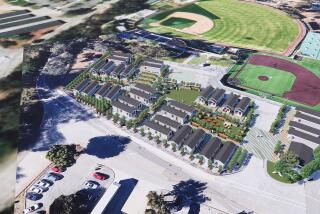CSU Campus Planners Get Local Input
- Share via
Area residents and community leaders on Thursday told planners of a new Cal State Ventura County campus that they would like a college with minimal traffic, hidden or underground parking lots and possibly a football stadium to be shared with other schools.
The campus should also be designed so that agriculture in the surrounding area is preserved, said one resident attending a meeting at the County Government Center in Ventura.
Some in the audience of about 50 people worried that the campus would create too much pressure to develop commercial businesses or apartments on surrounding land designated as the greenbelt buffer zone between the cities of Oxnard and Camarillo.
“I have talked with nearby landowners who are thinking about building apartments to service the university,” said Larry Rose, who represented Brokaw Nursery in Saticoy. “I encourage the university to think more deeply about maintaining the agriculture integrity of the area.”
But letters read by representatives from elected officials welcomed the university and cautioned the community to push ahead to build the campus that has been decades in coming to the county.
“The community must continue working together, be diligent in their support and never lose sight of the vision of a four-year university in this county,” said Sen. Gary K. Hart (D-Santa Barbara) in a letter read by his representative. Hart sponsored the legislation that set aside the first $7 million to buy property for a university.
Thursday’s meeting, called to hear community concerns and desires for the campus, was the first in a series planned over the next several years while a university is being developed in what is now a lemon orchard west of Camarillo. No further dates for community meetings have yet been set, but planners assured residents that all their opinions will be considered.
The first Cal State site in Ventura County was purchased in the 1960s in the Somis area, but was sold off in the early 1970s.
The present site was selected in 1991, after a seven-year battle to find a location in Ventura County that was suitable and politically acceptable to nearby residents and elected officials.
During that time, the state economy turned sour and Cal State operating and maintenance budgets were cut, leaving little funding for such capital projects as new campuses.
In addition, one of the two property owners has refused to sell his land. But the university is moving slowly forward and has filed to take the property by eminent domain. Cal State officials said they hope to have some resolution within the next three months, but the process could drag on for years.
But the state, with its deep financial troubles, will have to look to the private sector more than ever to help make the 23rd campus in the Cal State system a reality, said Chancellor Barry Munitz.
“We will have to have public-private partnerships, not just in donations of money, but in services, equipment, time (and) expertise,” he said.
Munitz said he does not want the new campus to be limited by design ideas used in building existing campuses.
“We met with the master planning architects and we told them over and over again to stretch our minds and don’t be traditional and don’t be conservative,” Munitz said.
On Thursday, Jean Marie Gath, the lead architect with the firm Hardy Holzman Pfeiffer Associates, told residents the new campus will have the kind of advanced technology that will allow “distance learning,” in which the instructor is in one location and the students in another.
But the campus will also be a social center, she said, with enough open space for students to gather. She said the university may use public transportation, or electric cars to cut down on the traffic to the campus.
The university may also build housing on campus to accommodate not just students but faculty and staff as well.
William Lawson, dean of continuing education at Oxnard College, said a sports stadium is needed at the university as well as by other colleges in the community.
David Leveille, director of institutional relations for the university, said a stadium would generate heavy traffic. But a stadium, like a theater, is the kind of public-private partnership the university wants to pursue.
John Rush, president of the Las Posas Property Owners Assn., said the campus entrance should be along Santa Clara Avenue to keep student traffic out of his neighborhood.
But planners said there would probably be a main entrance along Central Avenue, between two tall wind rows of eucalyptus trees, to give students “a sense of arrival.”
Others, like Norma Lagomarsino, were concerned that vast paved areas for parking would ruin the appearance of the campus.
“It’s important that the parking lots look nice with landscaping so that the college doesn’t look like a shopping mall,” said Lagomarsino, whose husband, former Rep. Bob Lagomarsino, also attended the meeting.
Gath assured Lagomarsino and others that parking lots would probably be spread out in small areas and would be obscured by trees and other landscaping.
But underground parking is not being considered, because it is prohibitively expensive at $22,000 per space, compared to about $1,000 per space for regular parking, Gath said.
“Were it not for the $22,000 cost per parking space, it would be nice to bury the parking lots and this campus and farm over the top of it,” joked Rose of the Brokaw Nursery.
FYI
To submit written comments about plans for a Cal State University campus in Ventura County, write to David Leveille, Director of Institutional Relations, California State University, 400 Golden Shore, Long Beach, Calif. 90802-4275.
More to Read
Sign up for Essential California
The most important California stories and recommendations in your inbox every morning.
You may occasionally receive promotional content from the Los Angeles Times.













